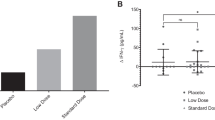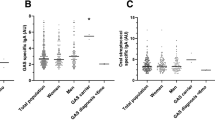Summary
Oral ‘Ribomunyl’ has been shown to increase levels of specific salivary IgA. The ability of specific salivary IgA to inhibit the adhesion of Streptococcus pneumoniae to buccal epithelial cells was investigated in vitro using 13 saliva samples from healthy volunteers who received ‘Ribomunyl’ therapy for 3 weeks. The S. pneumoniae strain contained in ‘Ribomunyl’ was [3H]thymidine-labelled and pretreated with dilutions of saliva for 1 hour at 37°C. Bacterial adhesion was measured after 2 hours’ contact with human oral epidermal cell monolayers at 37° under CO2. Nonadherent bacteria were washed off, and the residual radioactivity of the monolayers was compared with that of bacteria not pretreated with saliva.
A significant decrease (p < 0.05) in S. pneumoniae adhesion was observed with 6 saliva samples with high levels of specific IgA. This decrease was seen at all dilutions from 1/5 to 1/1000. In contrast, no significant modification of adhesion was seen in the 7 saliva samples with unmodified levels of IgA.
These data demonstrate that the increase in salivary IgA levels during ‘Ribomunyl’ therapy was linked with the capacity of saliva samples to specifically and efficiently inhibit adhesion of S. pneumoniae to buccal epithelial cells in vitro.
Similar content being viewed by others
References
Underdown BJ, Schiff JM. Immunoglobulin A: strategic defense initiative at the mucosal surface. Ann Rev Immunol 1986; 4: 389–417
Kolopp-Sarda JF, Béné MC, Allaire JM, et al. Kinetics of specific salivary responses in humans after oral challenge by a ribosomal immunostimulant. Int J Immunopharmacol. In press
Lampe RM, Mason JR, Kaplan SL, et al. Adherence of Haemophilus influenzae to buccal epithelial cells. Infect Immun 1982; 35(1): 166–72
Chauvière G, Coconnier MH, Kernéis S, et al. Adhesion of human Lactobacillus acidophilus strain LB to human enterocyte-like Caco-2 cells. J Gen Microbiol 1992; 138: 1689–96
Roitt IM. Immunologic. Paris Éditions Pradel 1990: 155
Faure GC, Béné MC, Simon C, et al. Increase of specific antibody forming cells in human tonsils after oral stimulation with D-53, a ribosomal vaccine. Int J Immunopharmacol 1990; 12: 315–20
Zanin C, Perrin P, Béné MC, et al. Antibody-producing cells in peripheral blood and tonsils after oral treatment of children with bacterial ribosomes. Int J Immunopharmacol 1994; 16: 497–505
Author information
Authors and Affiliations
Rights and permissions
About this article
Cite this article
Hbabi-Haddioui, L., Roques, C. Inhibition of Streptococcus pneumoniae Adhesion by Specific Salivary IgA after Oral Immunisation with a Ribosomal Immunostimulant. Drugs 54 (Suppl 1), 29–32 (1997). https://doi.org/10.2165/00003495-199700541-00008
Published:
Issue Date:
DOI: https://doi.org/10.2165/00003495-199700541-00008




